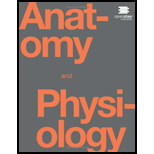
Concept explainers
A monosaccharide is formed from a polysaccharide in what kind of reaction?
oxidation-reduction reaction - anabolic reaction
- catabolic reaction
- biosynthetic reaction
Introduction:
The monosaccharide are the simplest form of sugars molecules. The more than three monosaccharide molecules form a polysaccharide molecule. The polysaccharide are formed by joining more than three monosaccharide molecules.
Answer to Problem 1RQ
The correct answer is option (c) catabolic reaction.
Explanation of Solution
Explanation/justification for the correct answer:
Option (c) catabolic reaction. The formation of monosaccharide from the complex polysaccharide molecules is a type of catabolic reaction. The polysaccharide molecule undergoes a catabolic reaction in which the complex polysaccharide molecule breaks into simple monosaccharide molecules with the release of water molecules. So, the correct answer is option (c).
Explanation for incorrect answer:
Option (a) oxidation-reduction reaction. It involves the transfer of electrons between two molecules. It involves the change in oxidation number of the molecules by accepting or donation electrons. In the conversion of polysaccharide into monosaccharide there is no exchange of electrons. So, this is an incorrect option.
Option (b) anabolic reaction. An anabolic reaction is a type of metabolic reaction, which involves energy to build up the simple molecules into complex molecules. These reaction are endergonic in nature. So, this is an incorrect option.
Option (d) biosynthetic reaction. The biosynthetic reaction is a type of anabolic reaction, it is a multistep and enzyme catalysed reaction. In this reaction the substrate molecules are converted into more complex molecules. So, this is an incorrect option.
The polysaccharide molecule undergoes a catabolic reaction in which the complex polysaccharide molecule breaks into simple monosaccharide molecules with the release of water molecules. Hence, the correct answer is option (c) catabolic reaction.
Want to see more full solutions like this?
Chapter 24 Solutions
Anatomy & Physiology
Additional Science Textbook Solutions
Microbiology: An Introduction
Campbell Biology: Concepts & Connections (9th Edition)
Chemistry: The Central Science (14th Edition)
Human Physiology: An Integrated Approach (8th Edition)
Human Anatomy & Physiology (2nd Edition)
Genetic Analysis: An Integrated Approach (3rd Edition)
- Explain how the hormones of the glands listed below travel around the body to target organs and tissues : Pituitary gland Hypothalamus Thyroid Parathyroid Adrenal Pineal Pancreas(islets of langerhans) Gonads (testes and ovaries) Placentaarrow_forwardWhat are the functions of the hormones produced in the glands listed below: Pituitary gland Hypothalamus Thyroid Parathyroid Adrenal Pineal Pancreas(islets of langerhans) Gonads (testes and ovaries) Placentaarrow_forwardDescribe the hormones produced in the glands listed below: Pituitary gland Hypothalamus Thyroid Parathyroid Adrenal Pineal Pancreas(islets of langerhans) Gonads (testes and ovaries) Placentaarrow_forward
- Please help me calculate drug dosage from the following information: Patient weight: 35 pounds, so 15.9 kilograms (got this by dividing 35 pounds by 2.2 kilograms) Drug dose: 0.05mg/kg Drug concentration: 2mg/mLarrow_forwardA 25-year-old woman presents to the emergency department with a 2-day history of fever, chills, severe headache, and confusion. She recently returned from a trip to sub-Saharan Africa, where she did not take malaria prophylaxis. On examination, she is febrile (39.8°C/103.6°F) and hypotensive. Laboratory studies reveal hemoglobin of 8.0 g/dL, platelet count of 50,000/μL, and evidence of hemoglobinuria. A peripheral blood smear shows ring forms and banana-shaped gametocytes. Which of the following Plasmodium species is most likely responsible for her severe symptoms? A. Plasmodium vivax B. Plasmodium ovale C. Plasmodium malariae D. Plasmodium falciparumarrow_forwardStandard Concentration (caffeine) mg/L Absorbance Reading 10 0.322 20 0.697 40 1.535 60 2.520 80 3.100arrow_forward
- please draw in the answers, thank youarrow_forwarda. On this first grid, assume that the DNA and RNA templates are read left to right. DNA DNA mRNA codon tRNA anticodon polypeptide _strand strand C с A T G A U G C A TRP b. Now do this AGAIN assuming that the DNA and RNA templates are read right to left. DNA DNA strand strand C mRNA codon tRNA anticodon polypeptide 0 A T G A U G с A TRParrow_forwardplease answer all question below with the following answer choice, thank you!arrow_forward
 Concepts of BiologyBiologyISBN:9781938168116Author:Samantha Fowler, Rebecca Roush, James WisePublisher:OpenStax College
Concepts of BiologyBiologyISBN:9781938168116Author:Samantha Fowler, Rebecca Roush, James WisePublisher:OpenStax College Anatomy & PhysiologyBiologyISBN:9781938168130Author:Kelly A. Young, James A. Wise, Peter DeSaix, Dean H. Kruse, Brandon Poe, Eddie Johnson, Jody E. Johnson, Oksana Korol, J. Gordon Betts, Mark WomblePublisher:OpenStax College
Anatomy & PhysiologyBiologyISBN:9781938168130Author:Kelly A. Young, James A. Wise, Peter DeSaix, Dean H. Kruse, Brandon Poe, Eddie Johnson, Jody E. Johnson, Oksana Korol, J. Gordon Betts, Mark WomblePublisher:OpenStax College Human Heredity: Principles and Issues (MindTap Co...BiologyISBN:9781305251052Author:Michael CummingsPublisher:Cengage Learning
Human Heredity: Principles and Issues (MindTap Co...BiologyISBN:9781305251052Author:Michael CummingsPublisher:Cengage Learning Human Biology (MindTap Course List)BiologyISBN:9781305112100Author:Cecie Starr, Beverly McMillanPublisher:Cengage LearningEssentials of Pharmacology for Health ProfessionsNursingISBN:9781305441620Author:WOODROWPublisher:Cengage
Human Biology (MindTap Course List)BiologyISBN:9781305112100Author:Cecie Starr, Beverly McMillanPublisher:Cengage LearningEssentials of Pharmacology for Health ProfessionsNursingISBN:9781305441620Author:WOODROWPublisher:Cengage





